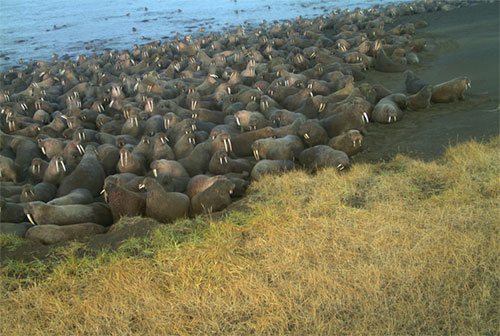
Pacific walruses haul out near Point Lay earlier than in previous yearsTribal government requests help preventing human-caused distubances
August 20, 2017
The formation of coastal haulouts along the Chukchi Sea coast in recent years is associated with the loss of sea ice habitat near offshore feeding grounds. The walruses typically begin to haul out approximately two weeks after sea ice recedes off the continental shelf. This year, sea ice has retreated beyond the continental shelf earlier than in previous years. Sea ice provides protection from predators and easy access to feeding areas below. Walruses would normally rest on the sea ice in small groups and occasionally slip into the water to feed.
The Point Lay haulout is used primarily by adult females and young animals. While on shore the animals are skittish and stampede to the water in response to unusual sights, sounds and odors. The young animals are vulnerable to being trampled in the process. The people of Point Lay have seen dead animals on shore after observing plane and boat activities in the area. In a videotaped interview, Tribal Council President Leo Ferreira III said, “It was kind of heartbreaking to see that these animals were being wasted this way, in this manner." “We’re trying to protect the walruses from disturbance by aircraft, boat, and ship activity in our area.” In past years, people have flown to the village to try to see and photograph the animals. The Native Village of Point Lay is concerned about the risk of disturbance from this type of activity and does not have infrastructure to support tourists. “Could you please respect the Point Lay residents and not come to Point Lay and ask to go take an excursion ride, which is about 2,3,4,5 miles away from this community to go take pictures of the walruses,” Ferreira said in the interview. “Because we feel like even the pictures will disturb the walruses when they’re congregated on the beach.” Pacific walruses are an important food source for the St. Lawrence Island Yupik, Iñupiaq, and Central Yup’ik communities along the coast of Alaska and have been part of their cultures for thousands of years. They have always cared for the animals, but want to stress the importance of stewardship now more than ever. The Native Village of Point Lay has taken a lead role in stewardship of the walrus haulout in order to prevent human-caused disturbance events. The Service has coordinated with the community to notify the Federal Aviation Administration, U.S. Coast Guard, air carriers and shipping companies to let them know that the walruses are there and to recommend they follow the Service’s guidelines if they travel in the area. The FAA and the Coast Guard issues the guidelines provided by the Service to pilots and mariners. Jonathan Snyder, a USFWS wildlife biologist who has worked with the Native Village of Point Lay over the last several years, said, “They have provided invaluable leadership, local expertise and on-the-ground support for monitoring the haulout and preventing human-caused disturbances. We greatly appreciate what they are doing.” “This early haul out shows that Pacific walruses are in terrible trouble,” said Emily Jeffers, a Center for Biological Diversity attorney. “If we’re going to save these amazing animals, the Trump administration has to give them the protections they need and stop pushing for dangerous oil drilling in the Arctic.” Quoting a news release from the Center for Biological Diversity, President Trump’s decisions to withdraw from the Paris climate accord and consider opening up the Arctic to offshore oil drilling would exacerbate sea ice loss and other threats to Pacific walruses. The Center said the U.S. Wildlife Service has previously said the Pacific walrus deserves listing under the Endangered Species Act, but it didn’t have the resources to proceed with listing, prompting the Center’s lawsuit and the imminent listing decision. Arctic sea ice extent, on which the Pacific walrus so heavily relies, hit record lows during fall 2016 and winter 2017, and sea ice in the Chukchi Sea off Point Lay retreated at a record rate this May. The sea ice is expected to begin increasing with the end of the summer season, although the National Snow and Ice Data Center cautioned that levels could continue to fall again, as happened in 2010 and 2005. Local villagers in Point Lay are helping protect the walruses and cautioning the general public against doing anything to scare or disrupt them. Mass walrus haul-outs were first observed in 2007, when Arctic sea-ice extent dropped 1 million square miles below average — losing an area the size of Alaska and Texas combined. “Trump’s hostility to conservation laws and threat to open up the Arctic put Pacific walruses under siege,” Jeffers said. “We need to protect this vital, vulnerable region before it’s too late.” In the United States, all marine mammals are protected under the Marine Mammal Protection Act, which makes it illegal to disturb or harass them. In simple terms, it is unlawful to change the behavior of any marine mammal in its natural environment without specific authorization to do so. Some exceptions are made for authorized scientific research and subsistence harvest by Alaska Natives. Violations of the Act are punishable by fine up to $100,000 and one year of imprisonment. See 16 USC 1361-1407.
Related Information:
Editing by Mary Kauffman, SitNews
Source of News:
Representations of fact and opinions in comments posted are solely those of the individual posters and do not represent the opinions of Sitnews.
|
|||
